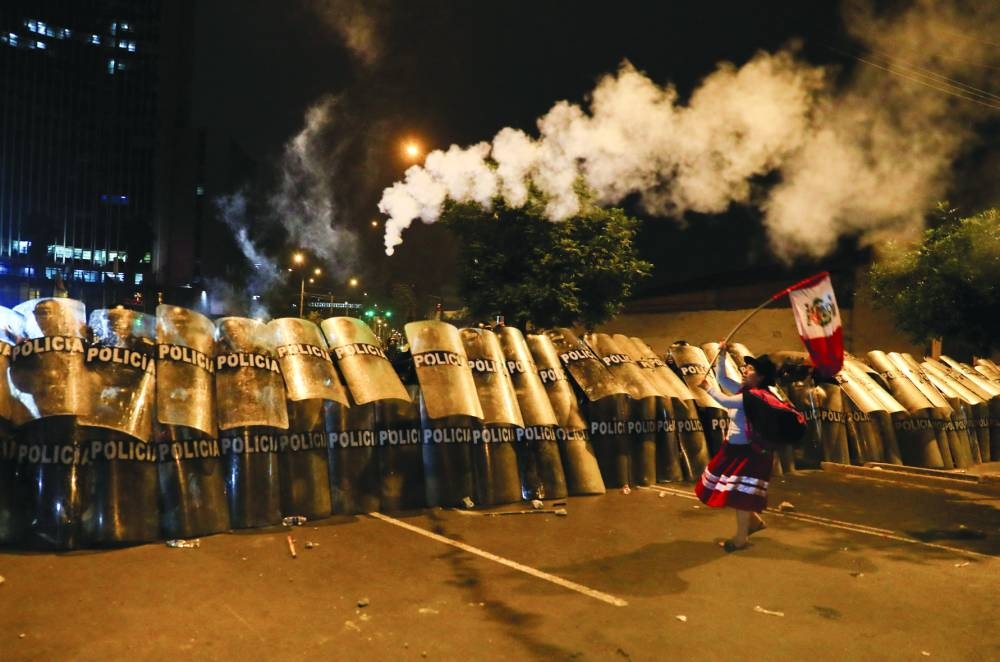Dozens of Peruvians were injured after tensions flared again on Friday night as police clashed with protesters in anti-government demonstrations that are spreading across the country.
In the capital Lima, police officers used tear gas to repel demonstrators throwing glass bottles and stones, as fires burned in the streets, local TV footage showed.
In the country’s southern Puno region, some 1,500 protesters attacked a police station in the town of Ilave, Interior Minister Vicente Romero said in a statement to news media.
A police station in Zepita, Puno, was also on fire, Romero said.
Health authorities in Ilave reported eight patients hospitalised with injuries, including broken arms and legs, eye contusions and punctured abdomens.
By late afternoon, 58 people had been injured nationwide in demonstrations, according to a report from Peru’s ombudsman.
The unrest followed a day of turmoil in Thursday, when one of Lima’s most historic buildings burned to the ground, as President Dina Boluarte vowed to get tougher on “vandals”.
The destruction of the building, a near-century-old mansion in central Lima, was described by officials as the loss of a “monumental asset”.
Authorities are investigating the causes.
Romero on Friday claimed the blaze was “duly planned and arranged”.
Thousands of protesters descended on Lima this week calling for change and angered by the protests’ mounting death toll, which officially stood at 46 yesterday.
Authorities announced yesterday that yet another protester had died following demonstrations in the country’s south, with the victim arriving already deceased at the local hospital in Puno.
Protests have rocked Peru since president Pedro Castillo was ousted in December after he attempted to dissolve the legislature to prevent an impeachment vote.
The unrest has until this week been concentrated in Peru’s south.
In the Cusco region, Glencore’s major Antapaccay copper mine suspended operations on Friday after protesters attacked the premises – one of the largest in the country – for the third time this month.
Airports in Arequipa, Cusco and the southern city of Juliaca were also attacked by demonstrators, delivering a fresh blow to Peru’s tourism industry.
“It’s nationwide chaos, you can’t live like this. We are in a terrible uncertainty – the economy, vandalism,” said Lima resident Leonardo Rojas.
The government has extended a state of emergency to six regions.
Boluarte has dismissed calls for her to resign and hold snap elections, instead calling for dialogue and promising to punish those involved in the unrest.
“All the rigour of the law will fall on those people who have acted with vandalism,” Boluarte said on Thursday.
Some locals pointed the finger at Boluarte, accusing her of not taking action to quell the protests, which began on December 7 in response to the ouster and arrest of Castillo.
Human rights groups have accused the police and army of using deadly firearms.
The police say protesters have used weapons and homemade explosives.
Meanwhile, Peru has closed its famed tourist site Machu Picchu amid anti-government protests, its ministry of culture said yesterday, with hundreds of tourists having been left stranded near the Inca citadel amid deadly unrest.
Prior to yesterday’s closing of Machu Picchu, rail services to the site had already been suspended due to the track being damaged by demonstrators.
At least 400 people, including 300 foreigners, are stranded at the foot of the site, in the town of Aguas Calientes, and pleading to be evacuated.
“The closure of the Inca trails network and the Machu Picchu citadel has been ordered due to the social situation and to preserve the safety of visitors,” the ministry of culture said in its statement yesterday.
“We don’t know if a train will pick us up. All the tourists here are queuing to register” for evacuation, Chilean tourist Alem Lopez told AFP on Friday.
Tourists “cannot leave because the railway has been damaged in different places”, Tourism Minister Luis Fernando Helguero said on Friday.
“Some tourists have chosen to walk to Piscacucho, but that takes six hours or more and very few people can do it,” he said.
Piscacucho is the closest village to Machu Picchu that is connected to the roads.
In December, several hundred stranded tourists were evacuated from near the site.
International
Over 50 injured in Peru protest ‘chaos’
Peru closes famed tourist site Machu Picchu due to protests

A woman waves a Peruvian flag in front of riot police during the 'Take over Lima' march in Lima.
